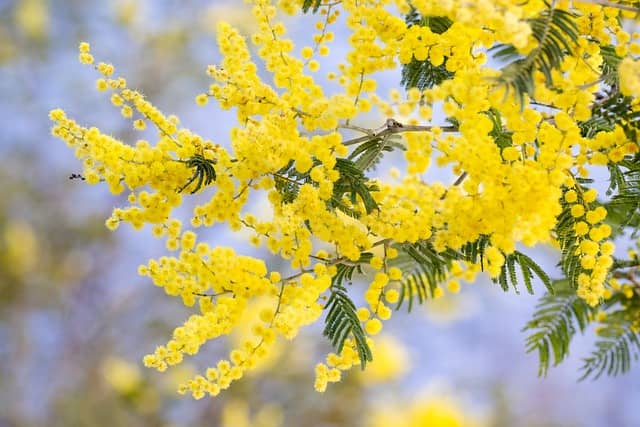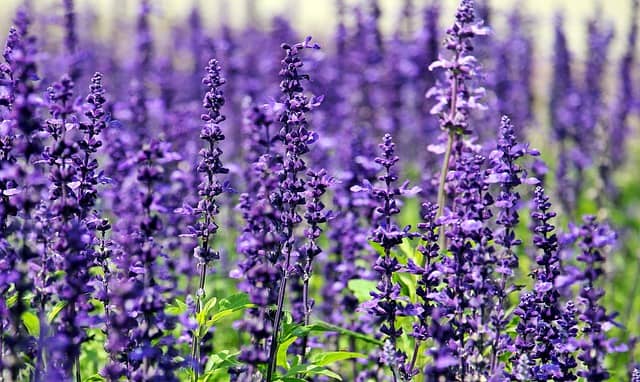Interdependence of Plants and Bees
The relationship between plants and bees has a long and fascinating history, dating back millions of years. The evolution of flowering plants, or angiosperms, was a critical turning point in the relationship between plants and bees. The first flowering plants are thought to have appeared around 140 million years ago, and over time they developed a variety of adaptations to attract pollinators, including bees.
Pollen is a crucial component for the reproduction of both bees and flowers, which has led to a co-evolutionary relationship that benefits both groups. Through the process of evolution, adult bees have developed unique behavioral and physiological adaptations to more effectively gather and transport pollen.
One such adaptation is buzz-pollination, where the flight muscles of bees create vibrations that dislodge pollen from flowers. This technique allows bees to extract pollen more efficiently from certain types of flowers, ensuring a steady supply of food for the colony.
Another adaptation is floral constancy, where individual pollinators specialize in foraging on a specific type of flower. This behavior allows the bee to become more proficient at collecting pollen from a particular plant species, which in turn increases the likelihood of successful pollination.
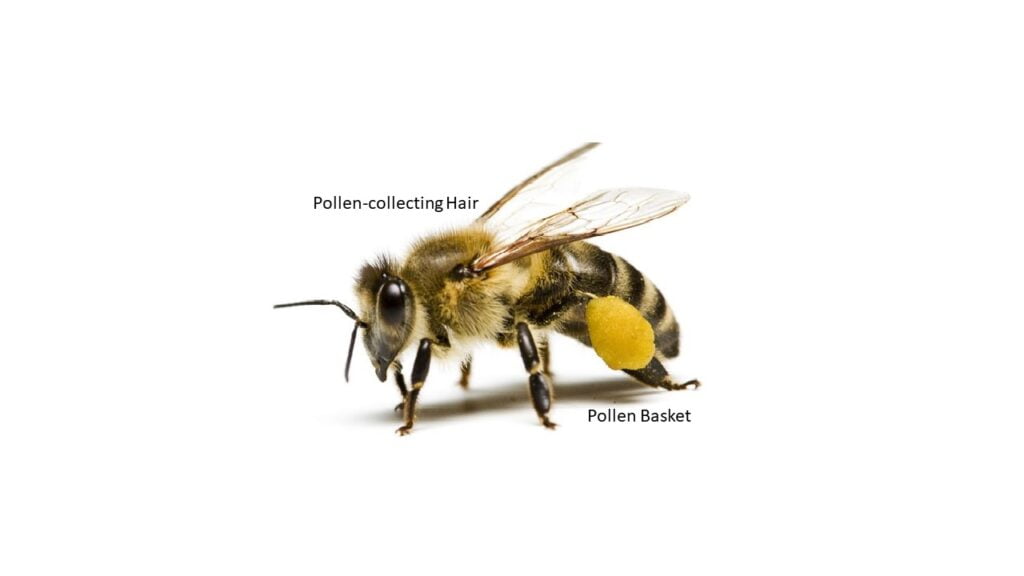
Bees have also developed specialized structures on their bodies to help them collect and transport pollen, such as pollen-collecting hairs and the infamous “pollen basket.” These structures are specifically designed to carry pollen back to the colony, where it can be used as a food source and to fertilize the queen bee.
Just as bees have adapted to more effectively collect and transport pollen, plants have also evolved a number of adaptations to better attract and utilize pollinators like bees. For example:
Brightly colored flowers: Many flowering plants have evolved to produce brightly colored flowers that are more easily seen by bees and other pollinators. These colors are often in the ultraviolet range, which is more visible to bees than to humans.
Sweet nectar: Plants have also evolved to produce sweet nectar, which attracts bees and encourages them to visit the flowers. Nectar is a critical energy source for bees, and by providing it, plants are able to encourage the bees to visit more flowers and potentially pollinate more plants.
Fragrance: Some plants also produce fragrances that attract bees and other pollinators. These fragrances can help guide bees to the flowers and encourage them to stay longer, increasing the likelihood of successful pollination.
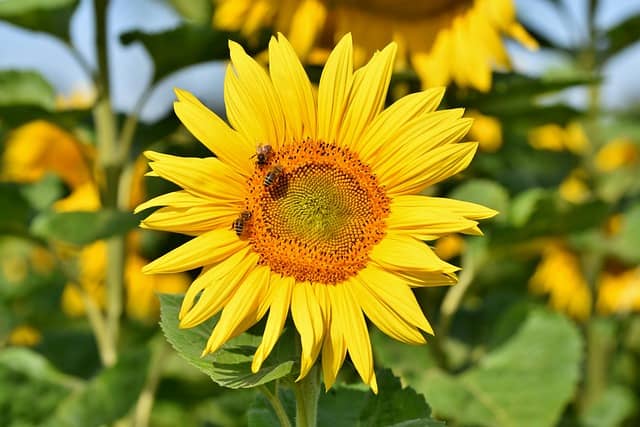
Specialized floral structures: Flower structures play a critical role in attracting pollinators with specific physical characteristics. For instance, shallow, clustered flowers with landing platforms, like sunflowers, are designed to lure in short-tongued pollinators such as sweat bees with easily accessible floral rewards. The flowers offer immediate and accessible nectar or pollen as a reward for their pollination services.
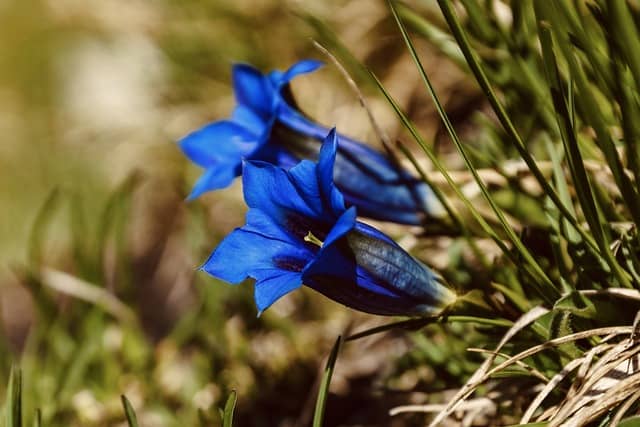
On the other hand, deep or tubular flowers without landing platforms have hidden floral rewards that require pollinators with long tongues or strong bodies to access them. These types of flowers often rely on specific pollinators like bumblebees to pry open the petals and climb inside to reach the reward. A classic example of this is the bottle or closed gentian (Gentiana spp.), whose flowers remain closed and depend entirely on bumblebees for pollination.
Further, plants have developed distinct phenology, or seasonal rhythms, that are closely synchronized with the life cycles of particular pollinators. This means that certain plants bloom at specific times of the year, in order to attract the most effective pollinators. On the other hand, some plants bloom continuously or sporadically throughout the growing season, in order to attract a variety of different pollinators.
The timing of these blooms can either invite or exclude certain types of pollinators based on the season or even the time of day. This is because different pollinators have different active periods, preferences, and behaviors, so plants must time their blooms accordingly to attract the most effective pollinators.
Plants that can save Our Pollinators
There are many types of plants that can provide important resources for pollinators, including nectar and pollen for food, and shelter and nesting sites. Some of the plants that save our pollinators are :
Aster
Asters are a fantastic option for supporting bees and other pollinators in your garden or landscape. These daisy-like flowers come in a range of colors, including blue, purple, pink, and white, and are known for their ability to attract a variety of pollinators, including bees, butterflies, and moths.
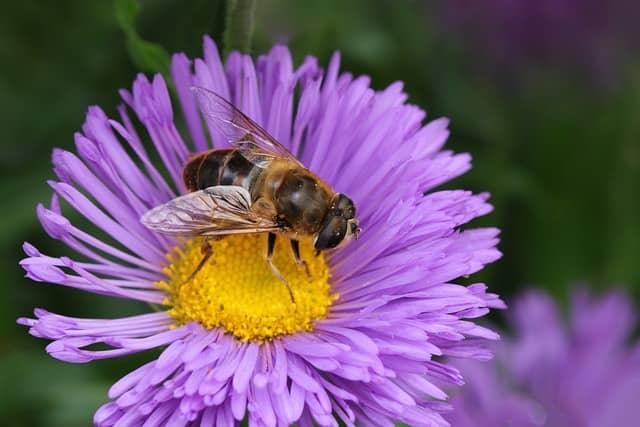
Asters bloom in late summer and fall, making them an important source of food for bees and other insects during the cooler months. They also have a unique flower structure that provides a landing pad for pollinators, making it easier for them to access the nectar and pollen inside the flowers.
In addition to being great for bees, asters are also a beautiful addition to any garden or landscape. They are easy to grow and require little maintenance, making them a great choice for beginner gardeners or those with limited time and resources.
Sunflower
Sunflowers are another fantastic choice for anyone looking to attract bees to their garden. These iconic flowers are not only beautiful and easy to grow, but they also provide an abundant source of nectar and pollen for bees and other pollinators.
Sunflowers come in a variety of sizes and colors, from small and compact to towering giants that can reach up to 16 feet tall. They bloom in the summer and fall, and their large, showy flowers are particularly attractive to bees, butterflies, and other insects.
In addition to being a great food source for bees, sunflowers also have a number of other benefits for the environment. They are a good source of seeds for birds, and their extensive root systems help to improve soil health and prevent erosion.
Acacia
Acacia is a genus of flowering plants that includes more than 1,000 species, many of which are highly attractive to bees. These trees and shrubs are native to regions around the world, from Africa and Australia to North and South America.
One of the reasons acacias are so popular among bees is because of the abundant nectar and pollen they produce. Bees collect nectar from the flowers and use it to make honey, while pollen is used to feed their young. In fact, acacia honey is highly prized for its delicate flavor and light color.
Acacia trees and shrubs also have a number of other benefits for the environment. They are highly drought-tolerant and can survive in harsh conditions where other plants might struggle. Their roots help to prevent erosion and improve soil health, and they provide important habitat for a variety of wildlife.
Raspberry
Raspberry plants (Rubus idaeus) are also excellent plants for attracting bees to your garden. They produce delicate white or pink flowers that bloom in spring and early summer, and are known for their sweet, juicy berries that ripen in mid to late summer.
Raspberry flowers are an excellent source of nectar and pollen for bees, and their long blooming period provides a consistent food source throughout the growing season. Bees are attracted to the bright pink flowers, which are easy for them to access and have a sweet fragrance.
Rose
Roses (Rosa spp.) are not only a beautiful addition to any garden, but they are also great for attracting bees. They produce large, showy blooms in a wide range of colors and are known for their sweet fragrance. Most roses produce little nectar, so pollen-collecting bees are the primary visitors.

Roses bloom from late spring through the summer and into the fall, providing a consistent food source for bees throughout the growing season. Some varieties, such as wild or heirloom roses, are particularly attractive to bees due to their simple, open flower structure.
While the majority of roses prefer soil that is moderate to dry, there are some exceptions, such as the swamp rose (Rosa palustris), which can withstand having wet roots. Roses work well as hedgerow and hedgerow understory plants. They incorporate equally well into shelterbelts, riparian buffer areas, and shrubby pastures.
Orange
Oranges (Citrus sinensis) are a great choice for attracting bees to your garden.
With orange blossom single colony can produce more than 100 pounds of surplus honey in a good season. This honey remains highly coveted for its thick, creamy consistency, snowy white hue, and delightful floral aroma. The average sugar concentration in the nectar of some orange species has been reported at 25%.
In addition to Citrus sinensis (and the many varieties of orange), kumquats (C. japonica) and other related fruits produce an abundance of bee-attracting flowers.
In addition to attracting bees, oranges also have many other benefits for the environment. They provide important habitat for wildlife and can help improve soil quality. They are also a source of fresh, healthy fruit for humans to enjoy.
Prunus Genus Plants
The Prunus genus is an incredibly valuable group of plants for early-season pollinators, such as mining bees and mason bees. In addition to cherry trees, the genus includes a wide variety of native and introduced trees and shrubs, many of which are popular ornamentals.
Some of the most popular Prunus species for attracting bees include:
Peach trees (Prunus persica): Peach trees produce beautiful pink blossoms in the spring that are rich in nectar and pollen.
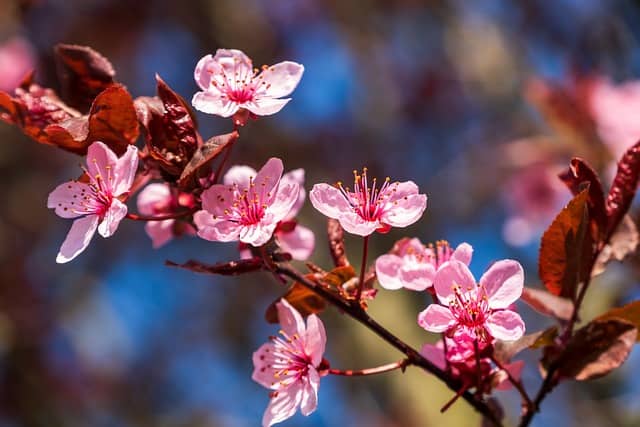
Plum trees (Prunus domestica): Plum trees are another popular choice for bee-friendly landscaping, with fragrant white or pink flowers that attract pollinators.
Apricot trees (Prunus armeniaca): Apricot trees produce early-blooming, pinkish-white flowers that are a valuable food source for bees and other pollinators.
Almond trees (Prunus dulcis): Almond trees are early-blooming and produce attractive pink or white flowers that are popular with bees.
Lavender
Lavender is a highly attractive plant for honey bees and other pollinators due to its fragrant, showy flowers. In addition to its importance as a honey plant, lavender has been widely used for culinary and medicinal purposes for centuries. The plant is native to the Mediterranean and Middle East but is now grown all over the world in regions with suitable climates.
Lavender blooms in the summer and produces large amounts of nectar with a sugar concentration that can range from 14 to 67 percent. The resulting honey is light golden in color and has a smooth, buttery texture when it granulates. Beekeepers in regions with commercial lavender farms have reported up to 40 pounds of surplus honey per colony, making it a highly valuable plant for honey production. Additionally, the essential oil of lavender is highly prized in the cosmetics and aromatherapy industries, making it a valuable crop for human use as well.
Basil
Basil is a culinary herb that is also popular with bees and other pollinators. Its small, white or purple flowers are a good source of nectar. Inexpensive and easily available, basil is a good candidate for including in the home garden as a temporary insectary strip: a row of quick-flowering annuals sown between other food crops to attract beneficial insects for both pollination and pest control.
Borage
Borage is a popular herb for both gardeners and pollinators, with attractive star-shaped blue to pink flowers that bloom from early summer to fall. This annual herb, originally from the Mediterranean region, is easy to grow and is often used in companion planting to attract bees and other beneficial insects to the garden.
Coriander
.Flowers of coriander bloom for a long period (sometimes more than a month) and produce large amounts of nectar, although it is low in sugar concentration. In addition to its attractive flowers, coriander is also known for its culinary uses. Its leaves, commonly known as cilantro, are a popular ingredient in many cuisines, especially in Latin American and Asian dishes. The seeds are also used as a spice in various cuisines, particularly in Indian and Middle Eastern dishes.
Hyssop
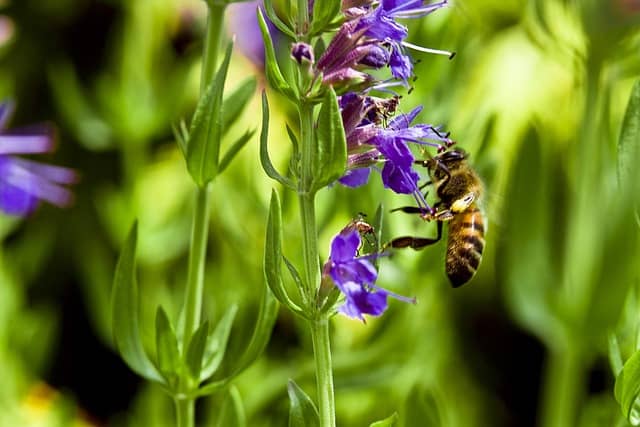
Hyssop is a woody shrub that is known for its aromatic leaves and pretty purple-blue flowers. It has been used for centuries as a medicinal herb and is believed to have a variety of health benefits, such as aiding digestion, relieving coughs and sore throats, and reducing anxiety. In addition to its medicinal properties, hyssop is also an important plant for honey bees. It produces large amounts of nectar, which bees use to make honey.
Mint
Mints are a group of plants in the genus Mentha, and they are known for their distinctive aroma and flavor. Mint plants are popular with pollinators, especially bees, because of their abundant nectar and pollen. Mints prefer to grow in rich, damp soils, and they can be aggressive under optimal conditions, spreading by underground rhizomes. Honey production can reach up to 200 pounds per colony near commercial mint fields, and the honey produced is amber in color and easily granulates with very small crystals. Mint is also a popular herb for culinary and medicinal purposes, and it can be easily grown in home gardens.
Oregano
Oregano is a fragrant perennial herb that belongs to the mint family, Lamiaceae. It is native to the Mediterranean region and is commonly used in Greek, Italian, and Mexican cuisine. Oregano is known for having one of the highest sugar concentrations in its nectar of any plant, up to 76%. The honey produced from oregano is famous in parts of Greece, where it originates on remote mountain meadows, and has been reported to yield surpluses of more than 40 pounds of honey per colony. In addition to its culinary uses, oregano has medicinal properties and has been used to treat respiratory tract disorders, gastrointestinal disorders, and menstrual cramps.
Rosemary
The evergreen herb rosemary is a compact shrub that is not very cold hardy. It typically blooms in late winter through spring and sometimes flowers again in autumn, depending on the climate. Its hemlock-like foliage and blue flowers make it an attractive addition to dry, exposed locations, and it is suitable for xeriscape gardens and hedges in warm climates. Rosemary is often grown in containers in cold climates, then moved inside during the winter months to be used as a house plant since it will not survive harsh winters.
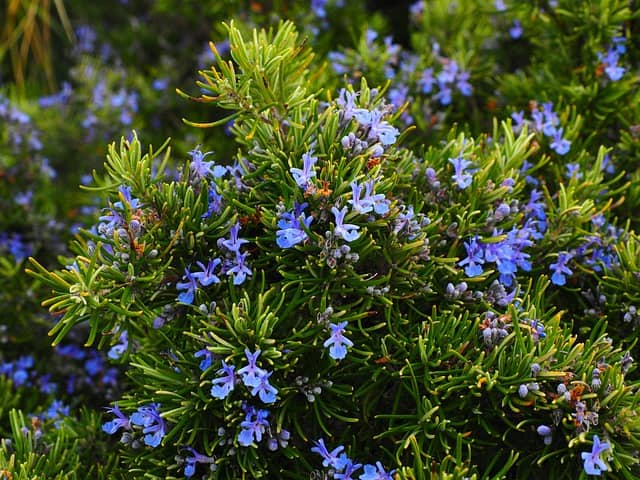
Honey bees are attracted to rosemary as a source of nectar, with sugar concentrations in the nectar ranging from 25 to 63%. Surplus honey production of up to 132 pounds per colony has been reported, with individual production rates of up to 15 pounds of rosemary honey per colony per day. The resulting honey is clear and water-white.
Alfalfa

Alfalfa is a crucial fodder and forage legume in the western region of the Missouri River and heavily relies on pollinators for seed production. Both perennial and annual varieties of alfalfa support a diverse range of pollinators. The alfalfa flower has two bottom petals that hold the stamen column under tension, which is released by visiting bees, resulting in pollen dusting on their bodies. However, honey bees have learned to bypass this process and instead rob nectar by using their tongues to probe the back of the flower. Alfalfa should only be planted in well-drained soils to avoid winterkill caused by frost heaving of roots. Nectar flows are best after wet springs, and the average sugar concentration in alfalfa nectar is typically between 41 and 44%. When alfalfa fields are stocked at 2 hives per acre, up to 300 pounds of honey per hive can be produced.
Conclusion
The relationship between bees and plants is vital for the survival of both, as well as humans. Bees rely on plants for food and shelter, while plants rely on bees for pollination and reproduction. There are many plant species that can save our pollinators. By planting these bee-friendly plants, we can help support pollinator populations and ensure the health and productivity of our food systems. It is important to continue researching and understanding the intricate relationship between bees and plants to help preserve biodiversity and ensure a sustainable future for our planet.

